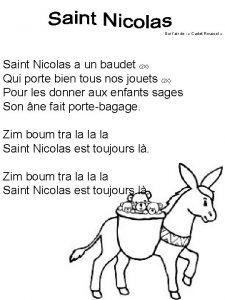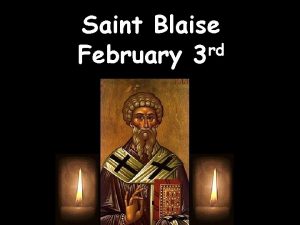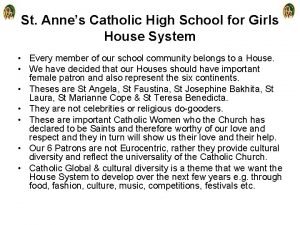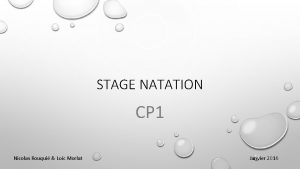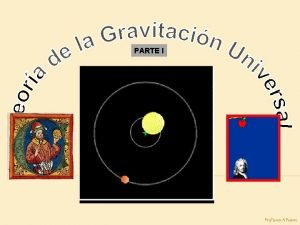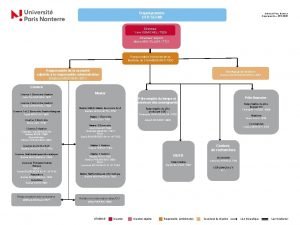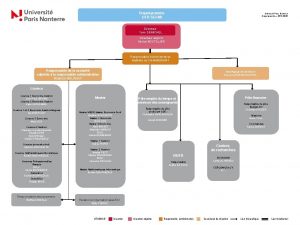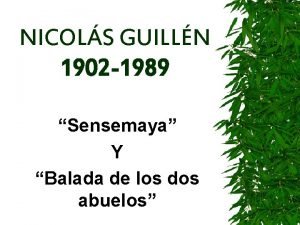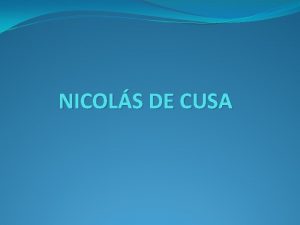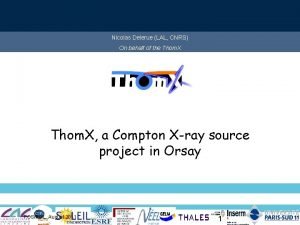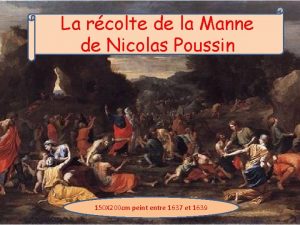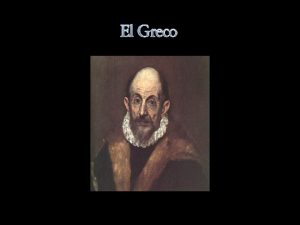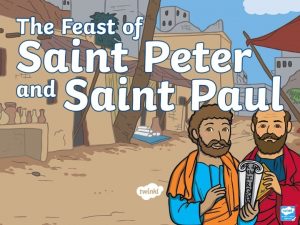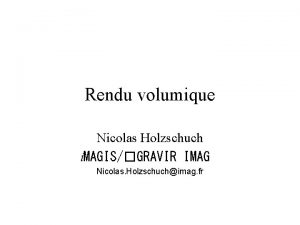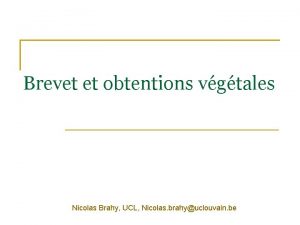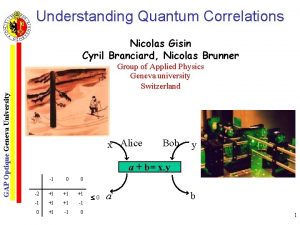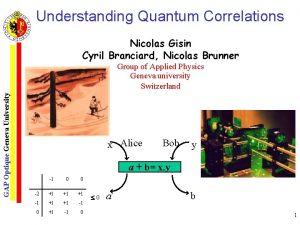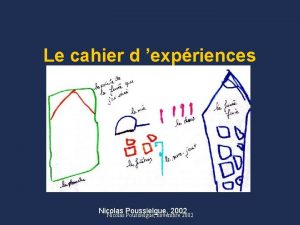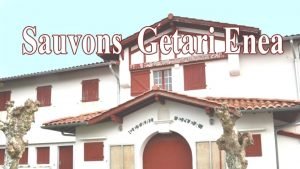Saint Nicolas Who is Saint Nicolas Who does

















- Slides: 17

Saint Nicolas

Who is Saint Nicolas ? • Who does he look like ? • A famous person who gives lots of presents… if you have been nice ! • Do you know ? • Try to guess… Très Bien !

« La Saint Nicolas » is celebrated on the 6 th of December each year. It is mostly present in Le Nord -Est de la France as well as in numerous European countries.

It is said that the legend of Father Christmas was created from the appearance of Saint Nicolas, which, in a way, makes Saint Nicolas the Ancestor of Le Père Noël ! St Nicolas is the Patron’s Saint of School children in Alsace Lorraine !

• « La Saint Nicolas » is also the opportunity for les enfants to have des cadeaux three weeks before Noël ! • As well, St Nicolas Day is a bank holiday in the North East of France, so everybody can enjoy the day !

The night before « La Saint Nicolas » , little children put their shoe in front of the cheminée before going to bed. Next to their shoe, they place une carotte, and some sucre, that St Nicolas’ mule can eat !

Since the VII century, it has been said that Saint Nicolas goes from houses to ask if les enfants have been good during the year that has passed. Good children receive des cadeaux and des bonbons, but not so good children are punished by Saint Nicolas’ opposite : Le père Fouettard !

Le père Fouettard Most children are scared about Le père Fouettard, because that man can take the bad children and put them into his “hotte” and take them where they will learn to be nice !

St Nicolas and his mule always brought presents to good children. In certain regions, St Nicolas is even more important than Father Christmas. Originally, presents brought by Saint Nicolas were intended to be eaten : • Dried fruit. • Appels • Cakes • Sweets • Chocolate. Nowadays though, presents tend to be more modern !

Nowadays Photos du feu d’artifice et du défilé !

Match the statements with the good person ! J’aide mes parents à la maison. I help my parents at home. Je n’aide pas mes parents à la maison. I do not help my parents at home.

Bonne Saint Nicolas ! • • On your card, write (in French): 1 thing you have been good for this year. 1 thing you have not been good for this year. Write your name !!! ______________________________________ ______________________________________

Quizz Who is Saint Nicolas ? When is « La Saint Nicolas » ? Where is « La Saint Nicolas » famous ? Who is the opposite of Saint Nicolas ? What can Le Père Fouettard do to children ? What kind of presents did Saint Nicolas originally give ? • What do children put next to their shoe for Saint Nicolas’ mule to eat ? • How many French words have you learnt ? ? • • •

• It is said that the legend of Father Christmas was created from the appearance of Saint Nicolas, which, in a way, makes Saint Nicolas the Ancestor of Father Christmas ! • « La Saint Nicolas » is celebrated on the 6 th of December each year. It is mostly present in the North-East of France as well as in numerous european countries. C'est l'un des saints le plus souvent représenté dans l'iconographie religieuse : sur les vitraux des églises, dans les tableaux, en statue, sur les taques de cheminée, les images d'Epinal, etc. . . Ses légendes offraient aux imagiers une riche matière. He is one of the religious iconography who is the most represented : he appears on churches windows, on paintings, statues etc.

• La Saint Nicolas est aussi l'occasion pour les enfants de recevoir des cadeaux trois semaines avant que le Père Noël ne passe dans les cheminées. • « La Saint Nicolas » is also the opportunity for children to have presents three weeks before Christmas ! • La veille de la Saint Nicolas, les petits enfants placent leurs souliers devant la cheminée avant d'aller se coucher. Il dépose à côté de leurs chaussures, une carotte et des sucres pour la mule du Saint Nicolas et un verre de vin pour réchauffer le grand Saint. • The night before « La Saint Nicolas » , little children put their shoe in front of the fireplace before going to bed. Next to tehir shoe, they place a carot, and some sugar, that St Nicolas’ mule can eat !

• Depuis le XIIe siècle, on raconte que Saint Nicolas, déguisé, va de maison en maison dans la nuit du 5 au 6 décembre pour demander aux enfants s'ils ont été obéissants. Les enfants sages reçoivent des cadeaux, des friandises et les méchants reçoivent une trique donnée par le compagnon de Saint Nicolas, le Père Fouettard. • Since the VII century, it is said that Saint Nicolas goes from houses to ask if children have been good during the year that has passed. Good children receive presents and sweets, but not good children are punished by Saint Nicolas’ opposite : Le père Fouettard ! • • Patron des ecoliers Jour ferié Dans la hotte frousse Pain d epice.

Les cadeaux de Saint Nicolas et son âne apportent toujours des cadeaux enfants qui ont varié selon les époques et selon les régions. Dans certains pays où certaines régions, saint Nicolas est encore plus important que le Père Noël. A l'origine, les cadeaux apportés par Saint Nicolas étaient destinés à être mangés : Fruits secs Pommes Gâteaux Bonbons Chocolats St Nicolas and his mule always brought presents to good children. In certain regions, St Nicolas is even more important than Father Christmas. Originally, presents brought by Saint Nicolas were intended to be eaten : • Dried fruit. • Appels • Cakes • Sweets • Chocolate.
 Saint nicolas du paradis apporte moi des jouets jolis
Saint nicolas du paradis apporte moi des jouets jolis Saint blaise patron saint of
Saint blaise patron saint of Vous me ferez un sanctuaire
Vous me ferez un sanctuaire Saint laura of saint catherine of siena
Saint laura of saint catherine of siena Courtois nombre completo
Courtois nombre completo Nicolas rouquie eps
Nicolas rouquie eps Dr nicolas kokkalis
Dr nicolas kokkalis Boyaval catherine france
Boyaval catherine france Doris pastore
Doris pastore Yann demichel
Yann demichel Sgami paris organigramme
Sgami paris organigramme Eufonia en balada de los dos abuelos
Eufonia en balada de los dos abuelos Pensamiento filosófico de nicolás de cusa
Pensamiento filosófico de nicolás de cusa Nicolas wicki
Nicolas wicki Nicolas notebaert
Nicolas notebaert Nicolas delerue
Nicolas delerue Nicolas delcroix
Nicolas delcroix Nicolas simar
Nicolas simar
